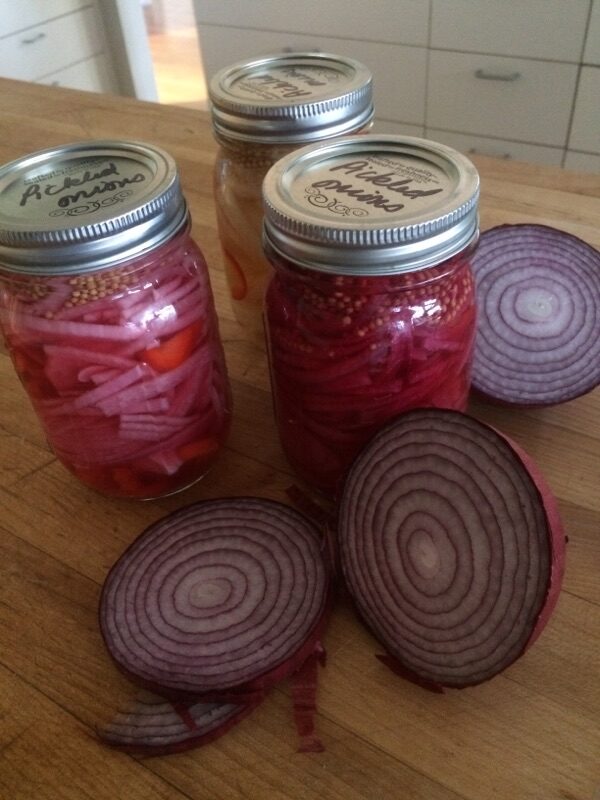See article following recipe about the importance of eating locally
Peach Blueberry Crisp
This recipe is easily adapted for apples in winter or pears and plums in autumn.
1 cup rolled oats
1/2 cup whole wheat pastry flour
1/2 teaspoon salt
1/4 cup cold-pressed vegetable oil
1/4 cup maple syrup
1/3 cup chopped nuts
2 tablespoons water
2 tablespoons maple syrup
1 teaspoon cinnamon
1/4 teaspoon nutmeg
2 teaspoons vanilla extract
1-2 tablespoons arrowroot or tapioca
1 pint blueberries
3 cups sliced peaches
Preheat oven to 350*. Mix oats, flour, and salt together in a bowl. Add oil and sweetener; mix well. Stir in nuts and set aside. In a small bowl combine water, syrup, spices, and vanilla extract; set aside. Slice fruit and place in a lightly oiled pie pan or an 8×8-inch baking dish.
Sprinkle arrowroot over the fruit. Pour the liquid mixture over the fruit and toss gently. Spoon the oat-nut mixture evenly on top of the fruit.
Cover and bake 45 minutes. Uncover and bake 15 minutes more to crisp topping.
Preparation time: 1 hour and 20 minutes
Makes 8 servings
This recipe is reprinted with permission from Bastyr University faculty member Cynthia Lair and her book Feeding the Whole Family (Moon Smile Press, http://www.feedingfamily.com)
The Importance of Eating Locally
…by Lisa Harvey, Beverly D. Kindblade, MS, RD, CD
These days we expect our grocery stores to carry a wide range of produce year-round, with peaches from Chili or tomatoes from Holland available in the dead of winter. Convenient as this is, we should be asking questions about what we really know about those foods—who grew them, where were they grown and most importantly, how far have they traveled? How much of a carbon footprint do they leave behind?
Out of season foods that have traveled long distances are not as healthy as locally grown foods found in season. As produce travels and ages, it begins to lose nutritional value. Eating locally ensures that your foods are providing nutrients, especially those from plants called “phytonutrients,” to your body at the appropriate season. This practice also helps keep you aware of the wonders and anticipations of the changing seasons. Is it not better to have just a few precious weeks to enjoy cherries bursting with flavor and nutrition than to have bland cherries with compromised nutritional value year-round? Eating seasonally will ensure that you are consuming the maximum levels of nutrients the food has to offer, as well as experiencing the peak of the food’s flavor and texture.
By eating locally grown seasonal foods, you are also helping to preserve our local farming economy and farming families. You also help preserve farmland from commercial and residential development.
This is the easiest time of year to eat seasonal foods from our local farms. Ask your grocer where your food comes from if the information is not posted. Make a point of talking with your grocer about obtaining local produce when possible. If the management hears enough requests, the product will appear.
Consider the possibility of participating in a Community Supported Agriculture program (CSA). These vary from program to program, but essentially the consumer pays the farm directly for a weekly share of the season’s production. This is an excellent way of getting to know and support a local farm and those who run it – not to mention the delicious produce you will receive.
Farmers markets are one of the easiest and most direct ways of accessing local produce. Several markets have sprouted up in towns throughout the area within the last few years. The farmers at the markets are often eager to discuss and educate the consumer about the goods they produce, which often include unique varieties not available at grocery stores. Tilth Alliance is another great resource to learn about fresh food: http://www.tilthalliance.org; 206-633-0451.
We have all been told how important it is to include fruits and vegetables in our diets. Why not maximize both the nutritional and sensual benefits with seasonally appropriate, locally grown produce?
Bastyr University, in Kenmore, Washington AND a clinic in Seattle’s Wallingford neighborhood, is the leading university for natural health sciences in the United States, encompassing a multidisciplinary curriculum and world-renowned research.

















